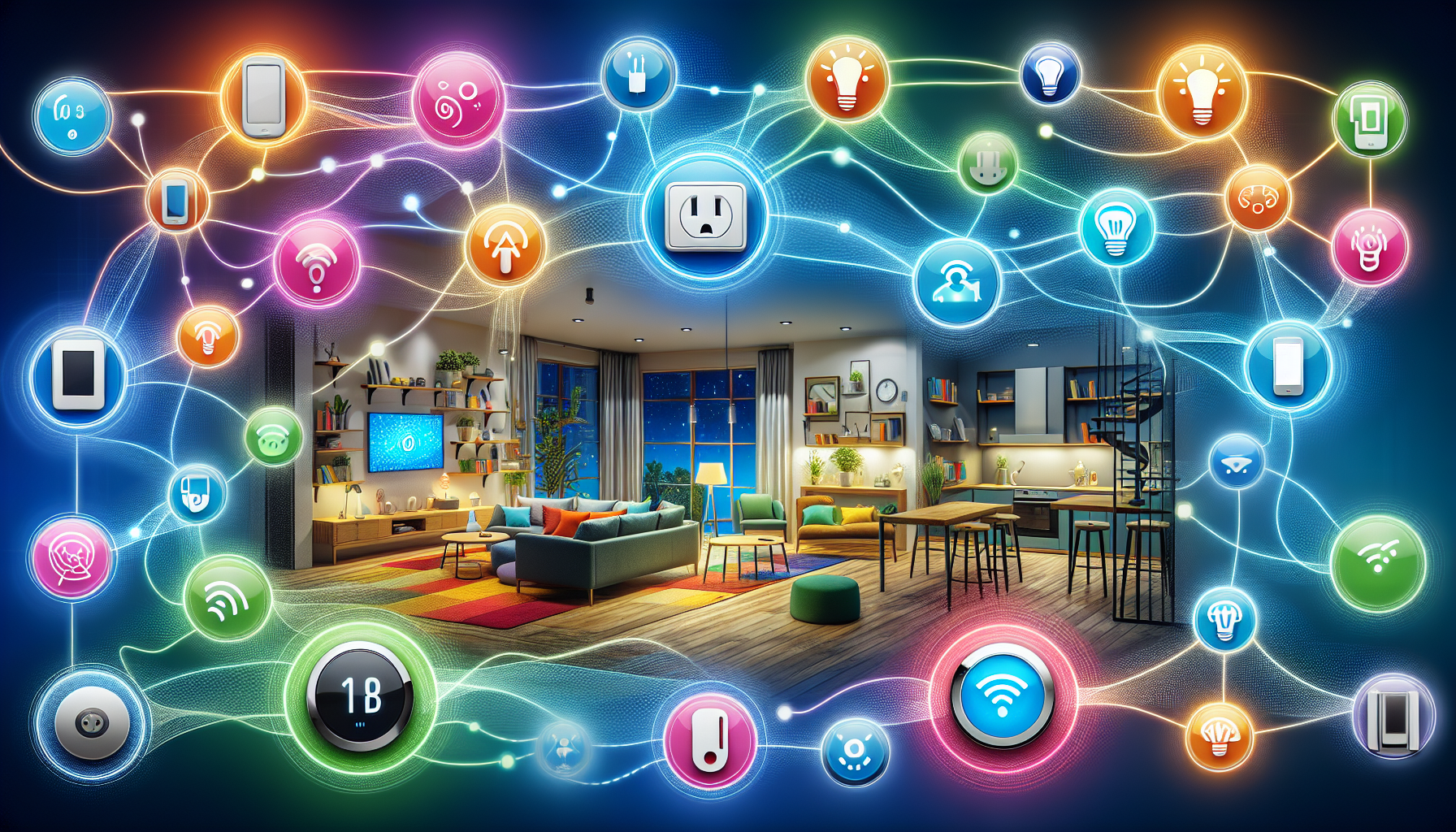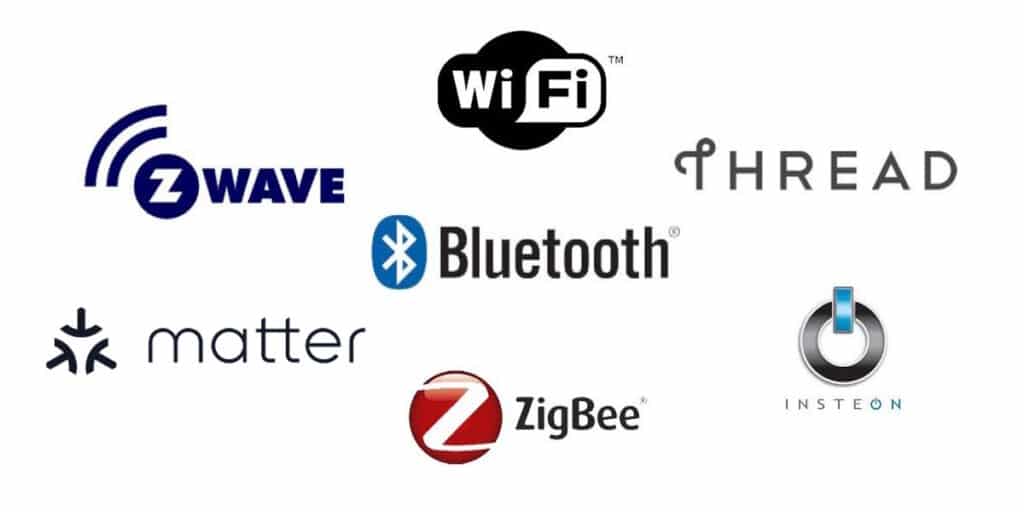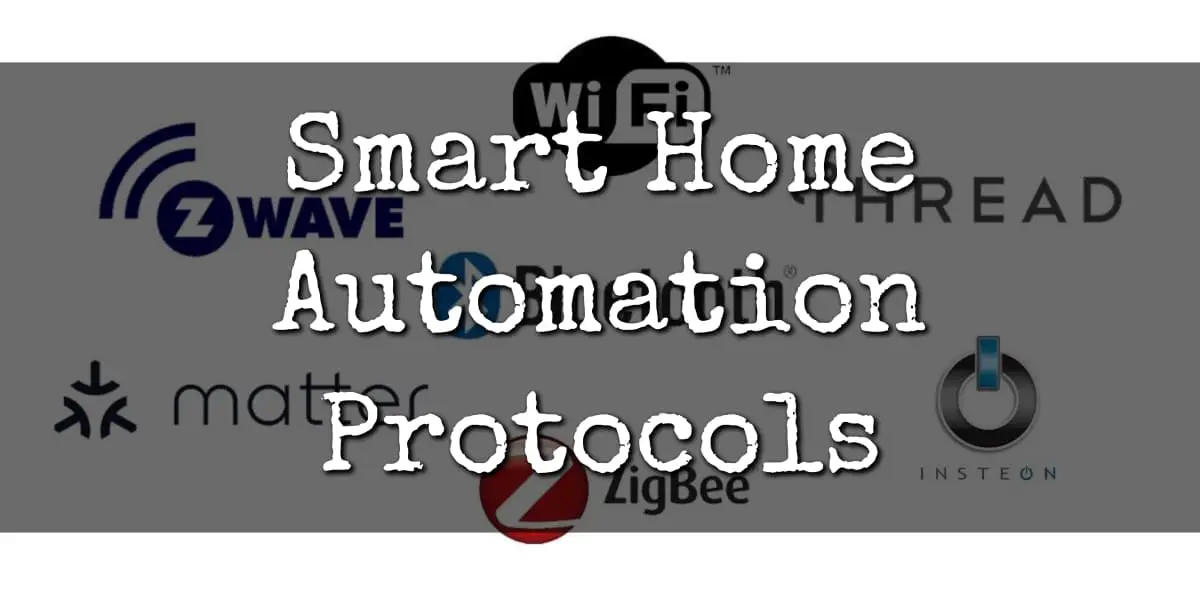Imagine waking up to the smell of freshly brewed coffee, the lights slowly brightening as the blinds lift to reveal the morning sun – all without you lifting a finger. That’s the magic of smart home automation, and it’s all made possible through various communication protocols. But if you’ve ever shopped for smart gadgets, you’ve probably found yourself wondering, “Wait, how do all these devices even talk to each other?”
In this article, we’re diving into the world of smart home automation protocols – Zigbee, Z-Wave, Wi-Fi, and more. We’ll break down how they work, compare their pros and cons, and help you figure out which one fits your lifestyle best. Ready to make your home smarter, easier, and more connected? Let’s get started!
Here's what we cover:
- Quick Facts
- Understanding Home Automation Protocols
- Wi-Fi: The Ubiquitous Choice
- Z-Wave: A Popular Wireless Mesh Network
- Zigbee: The Flexible Mesh Networking Solution
- Bluetooth Low Energy: Short-Range Connectivity
- Thread: The Emerging Contender
- Insteon: The Hybrid Approach
- Matter: The Future of Home Automation Protocols?
- Smart Home Protocols Comparison
- Choosing the Right Protocol for Your Smart Home
- Summary
- Frequently Asked Questions
Quick Facts
- Smart home protocols are what make devices compatible and talk to each other in a smart home.
- Wi-Fi, Z-Wave, Zigbee, Matter and Thread are the common protocols, each with their pros and cons.
- Choosing the right protocol affects device performance, battery life and overall functionality depending on your smart home needs.
Smart home protocols and home automation protocols are the behind the scenes heroes of home automation. They set the standards for communication between devices in a smart home, so your smart lights, locks, thermostats and other devices can talk to each other seamlessly. These smart home wireless protocols handle data exchange, authentication and error detection so your smart home devices work as intended.
The main job of these protocols is to make devices from different manufacturers compatible, so you can mix and match products without worrying about compatibility issues. But choosing the right protocol is key to avoid battery life and connectivity issues.
Understanding Home Automation Protocols

At the core of every smart home system are the protocols that make smart home devices talk to each other. These protocols set the standards for data exchange so devices from different manufacturers can work together. A smart home ecosystem means your smart plugs, smart lights and other devices can talk to each other.
Smart home protocols handle communication, authentication and error detection between smart devices which affects their performance and efficiency. Choosing the right protocol helps avoid battery life and connectivity issues, for a smooth smart home experience. Plus understanding smart home communication protocols is key to optimizing these interactions.
Common smart home protocols are Wi-Fi, Z-Wave, Zigbee, Bluetooth Low Energy, Thread and Matter.
Each of these protocols have their pros and cons, so it’s important to understand their differences. Most smart home protocols used today are wireless because of convenience, though Ethernet is an option for devices that need stable connections.
Wi-Fi: The Ubiquitous Choice

Wi-Fi is the most well known wireless protocol and is used in most smart home systems because of its high bandwidth and wide coverage. It’s perfect for applications that need constant use and high bandwidth like video doorbells, security cameras and streaming devices.
But Wi-Fi has its own set of problems. It’s known for high power consumption which can be a big issue for battery powered devices like smart locks and sensors. Wi-Fi is also prone to interference from other devices in the same frequency range which can affect its performance.
Despite these issues, Wi-Fi is still a popular choice for smart home connectivity especially for Wi-Fi devices that need a robust and wide ranging network. Its high bandwidth and wide coverage makes it the backbone of modern smart home systems.
Pros & Cons of Wi-Fi
Pros:
- Ubiquitous and compatible with most devices
- Fast data transfer rates
- Easy setup
- Broad compatibility
Cons:
- Higher power consumption
- Limited range
- Network congestion
- Security concerns
Z-Wave: A Popular Wireless Mesh Network

Z-Wave is a smart home protocol designed to provide communication over longer distances so it’s perfect for larger homes. It operates in the sub-GHz frequency range which avoids interference from typical Wi-Fi networks so it can communicate through thick walls.
One of Z-Wave’s best features is its mesh network structure which allows devices to relay signals to each other, creating a robust and self healing network. This mesh networking means your smart home devices will stay connected even if one device fails. Z-Wave is ideal for battery powered devices because of its low power consumption.
But Z-Wave has its limitations. Its data transmission speed is slower than some other protocols and has limited compatibility with third party devices which can limit your options. Despite these drawbacks Z-Wave’s reliability and mesh network makes it a strong contender for smart home automation.
Pros & Cons of Z-Wave
Pros:
- Low power consumption
- Strong signal range
- Mesh network for extended coverage
- Interoperability between different manufacturers
Cons:
- Requires a hub
- Limited device selection
- Higher cost
- Slower data transfer rates
Zigbee: The Flexible Mesh Networking Solution

Zigbee is another popular smart home protocol known for its power efficiency and low power consumption. It’s designed for low cost, low power wireless IoT communications so it’s perfect for various smart home devices. Zigbee’s power efficiency can extend the battery life of devices like smart security sensors by almost 7 years.
Zigbee has a robust security framework using AES-128 encryption so data transmission between smart home devices is secure. Its mesh infrastructure allows for multiple device interconnection, unlimited hops compared to Z-Wave’s 4 hops which can be a big advantage in larger setups.
But Zigbee is not without its issues. It can be affected by Wi-Fi and Bluetooth interference which can limit its performance in some environments. Its range might not be enough for larger homes so it’s not effective in big spaces. Despite these limitations Zigbee’s efficiency and wide adoption by major companies like Philips, Samsung and Amazon makes it a reliable choice for smart home automation.
Pros & Cons of Zigbee
Pros:
- Low power consumption
- Mesh network for extended range
- Interoperability between different manufacturers
- Scalability for large setups
Cons:
- Requires a hub
- Limited range of individual devices
- Interference from other devices
- Initial setup complexity
Bluetooth Low Energy: Short-Range Connectivity

Bluetooth Low Energy (BLE) is for short range communication so it’s perfect for smart home devices that require low power consumption. BLE is great for transmitting small data in bursts which is perfect for battery powered devices like wearables and home health monitoring systems.
One of BLE’s advantages is its low power consumption which extends the battery life of devices. It also supports a wide range of devices so interoperability within smart home ecosystems is promoted. And BLE is evolving to have better security features so it’s more reliable in smart home environment.
But BLE has limited range compared to other protocols so it’s not suitable for larger homes. Despite that its communication is efficient and connection times are fast so it’s a good protocol for some smart home applications.
Pros & Cons of BLE
Pros:
- Widely available
- Simple pairing without a hub
- Low power consumption
- Suitable for battery-operated devices
Cons:
- Limited range
- Potential interference
- Limited device compatibility
- Slower data transfer speeds
Thread: The Emerging Contender

Thread is a scalable and secure smart home protocol for low power consumption so it’s perfect for small and big smart home installations. It has built-in security layer so data is protected and communication within smart home network is secure.
Backed by big tech companies, Thread supports multiple device integration so it’s a major player in the smart home ecosystem. Its scalability and security features makes it a solid choice for modern smart home setups.
Pros & Cons of Thread
Pros:
- Low power consumption
- Mesh network for extended range
- Reliable and secure communication
- Interoperability between different devices
Cons:
- Limited device selection compared to Wi-Fi and Zigbee
- Requires Thread-compatible devices
- May require a hub or border router for internet connectivity
Insteon: The Hybrid Approach

Insteon uses both power lines and radio frequency for smart home connectivity, a unique approach compared to other protocols. This dual method connectivity has error checking and correction mechanism to ensure message reliability.
But Insteon has had security issues, including whitehat hacking that exposed vulnerabilities. Some Insteon protocols have been retired because of these security issues. Despite that Insteon is still a major player in the smart home industry.
Pros & Cons of Insteon
Pros:
- Dual-band technology (powerline and wireless) for reliable communication
- Broad compatibility with existing wiring infrastructure
- High reliability and low latency
- Supports a wide range of devices
Cons:
- Requires Insteon-specific devices for full compatibility
- Relatively limited device selection compared to other protocols
- Higher cost for Insteon-enabled devices
Matter: The Future of Home Automation Protocols?

Matter is a new connectivity standard to address the fragmentation in the smart home industry. Managed by the Connectivity Standards Alliance, Matter will unify devices from different brands for seamless integration.
Backed by over 550 companies including big tech players like Apple, Amazon and Google, Matter works over multiple communication methods including Thread, Wi-Fi and Ethernet. This multi-communication approach makes Matter a future proof standard for smart home ecosystems.
Pros & Cons of Matter
Pros:
- Interoperability between different smart home devices and platforms
- Simplified setup and configuration process
- Promotes industry collaboration and standardization
- Wide range of supported devices expected in the future
Cons:
- Limited device availability in the early stages
- Requires Matter-compatible devices and platforms
- Implementation and adoption may take time
Smart Home Protocols Comparison
Z-Wave, BLE, and Zigbee have low power consumption so are perfect for battery powered devices. Wi-Fi has high bandwidth but at the cost of higher power consumption.
Range is also an issue. Z-Wave can go up to 100 meters, Zigbee is limited to 10-20 meters indoors. Security is also a big factor. Wi-Fi has AES 256-bit encryption, Thread has AES-128 encryption and secure boot protocols to protect data.
Compatibility is also important. Z-Wave supports over 3,000 devices so interoperability is extensive. Knowing these differences will help you choose the right protocol for your needs.
| Zigbee | Z-Wave | BLE | Matter | Thread | Insteon | Wi-Fi | |
|---|---|---|---|---|---|---|---|
| Speed | 250 kbps | 40-100 kbps | 1 Mbps | Depends | 250 kbps | 2880 bps | Up to 1.3 Gbps |
| Range | 10-100 m | 30-100 m | 100 m | Depends | 10-30 m | 45-60 m | 50-100 m |
| Interoperability | High | High | Moderate | High | Moderate | Low | High |
| Network Type | Mesh | Mesh | Star | Depends | Mesh | Dual-mesh | Star |
| Security | High | High | High | High | High | High | High |
| Power Usage | Low | Low | Very Low | Varies | Low | Moderate | High |
Choosing the Right Protocol for Your Smart Home

Choosing the right smart home protocol is important so your hardware and software works together and meet your expectations. A wrong protocol choice can result to reduced battery life, limited signal range and unstable connections. Consider network range, interoperability, power efficiency, bandwidth and security.
Zigbee and Z-Wave is recommended for battery powered devices because of their low power usage. Devices that requires high bandwidth like security cameras and streaming devices are better suited for Wi-Fi or Ethernet.
Summary
Smart home protocols are the foundation of any home automation setup, so devices can talk to each other. From Wi-Fi’s high bandwidth to Zigbee’s low power consumption, each protocol has its pros and cons.
Choosing the right protocol is important for a smooth smart home experience. By considering power consumption, range and compatibility you can have a smart home that meets your needs and makes your life better.
Frequently Asked Questions
What are the most common smart home protocols?
The most common smart home protocols are Wi-Fi, Z-Wave, Zigbee, Bluetooth Low Energy, Thread, Ethernet, Insteon, and Matter.
Is Wi-Fi a good option for smart home automation?
Wi-Fi can be good but gets congested with many devices and consumes more power so not ideal for large or complex setup.
Why isn’t Wi-Fi good for battery powered devices?
Wi-Fi isn’t good for battery powered devices because it drains more power compared to low energy alternatives, so better to stick with low power protocols for longer use.
Are there security issues with Wi-Fi for smart home automation?
Yes, Wi-Fi devices can be hacked so strong passwords and encryption is important.
How does Bluetooth compare to Zigbee and Z-Wave for smart home?
Bluetooth has shorter range and no mesh networking so not ideal for whole home automation compared to Zigbee and Z-Wave.
Which is better for large homes, Zigbee or Z-Wave?
Z-Wave has longer range so slightly better for larger homes but both use mesh networking to extend coverage.
Why is Z-Wave good for larger homes?
Z-Wave is good for larger homes because its mesh network allows devices to communicate over longer distances and even through walls so you have strong connectivity throughout your space.
How does Zigbee secure communication?
Zigbee uses AES-128 encryption to secure communication so it’s a good choice to protect your smart home devices from unauthorized access.
What is the purpose of the Matter protocol?
Matter protocol is to make compatibility across smart home devices so devices from different brands can integrate seamlessly.
Can I use multiple protocols in my smart home system?
Yes, many smart home hubs support multiple protocols so different devices can work together.
How important is a smart home hub and which protocols need one?
A hub is needed for protocols like Zigbee and Z-Wave to manage devices while Wi-Fi and Bluetooth devices connect directly to a smartphone or router.
Can I switch protocols if I already have existing smart home setup?
Yes but might need new hardware like multi-protocol hub or compatible devices to integrate smoothly.
